
Taj Mahal India
Asia is probably the most diverse continent when it comes to culture, wonders and landmarks. Here, we have picked eight of the best, and some unusual, sites for you to visit.
Taj Mahal and Fatehpur Sikri, Uttar Pradesh, Agra, India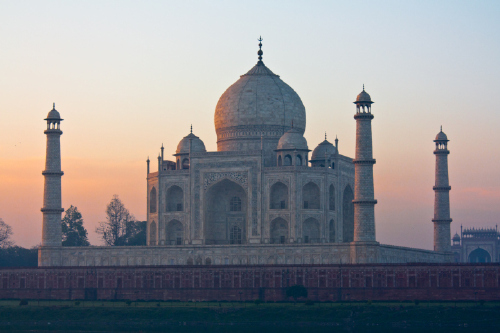 Possibly the most famous of the Seven Wonders of the World, the Taj Mahal is a stunning spectacle for all who visit. But, we’ve added a second stunning landmark here, anyone visiting Agra should also look to paying a trip to the fort of Fatehpur Sikri, an hour’s drive from the Taj.
Possibly the most famous of the Seven Wonders of the World, the Taj Mahal is a stunning spectacle for all who visit. But, we’ve added a second stunning landmark here, anyone visiting Agra should also look to paying a trip to the fort of Fatehpur Sikri, an hour’s drive from the Taj.
One of the most beautiful yet tragic love stories is engraved in the solid white walls of this building, the Taj Mahal was in fact built as a pure white-marble mausoleum, by the Mughal emperor Shah Jahan in memory of his third beloved wife, Mumtaz Mahal. The construction of the Taj Mahal took 22 years and the labour of over 20,000 workers, and it is rumoured that Shah Jahan had his workers hands cut off so that no such treasured site could ever be built by another.
The enormous complex built around the Taj boasts lush green gardens, brown stone benches, perfectly mowed lawns and large reflective pools of water. There is also a Mosque to the left and a guesthouse to the right, both adding to the impressive awe of this must-see wonder.
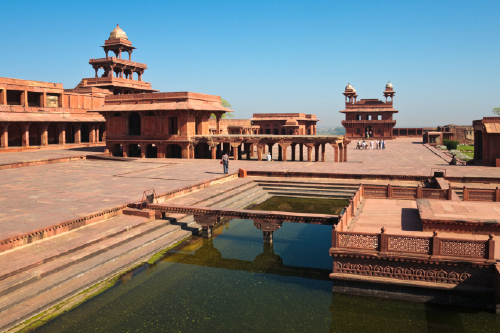 Fatehpur Sikri Complex
Fatehpur Sikri Complex
Fatehpur Sikri is one of the greatest legacies of the Mughal civilisation. Translating to ‘The City of Victory’, this was the capital of the Mughal Empire for around a decade in the 16th century when emperor Akbar had the new capital built to mark the birth of his son, Jahangir. Fatehpur Sikri is located 26 miles west of Agra and the complex visited by tourists comprises of monuments and temples, all in a uniform architectural style, blending both Islamic and Hindu elements. The compound is home to one of the largest mosques in India, the Jama Masjid.
Chocolate Hills, Bohol, Philippines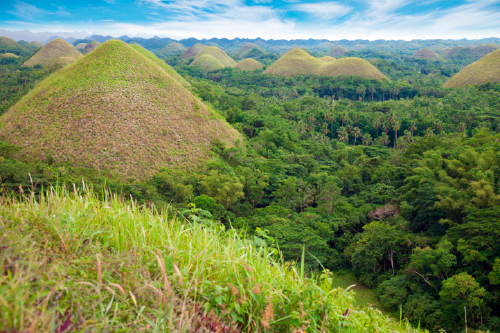 The giant Chocolate Hills in Bohol Province is an unusual geological formation consisting of at least 1,260 hills, though it has been said that the area may have up to 2,000 hills spread over more than 50sq kilometers. Though they are not fudge-like or edible, the grass-covered hills are a breathtaking natural sight, and one of the most unique wonders in the world.
The giant Chocolate Hills in Bohol Province is an unusual geological formation consisting of at least 1,260 hills, though it has been said that the area may have up to 2,000 hills spread over more than 50sq kilometers. Though they are not fudge-like or edible, the grass-covered hills are a breathtaking natural sight, and one of the most unique wonders in the world.
The approach on winding roads, to the mint-green limestone hills, is as breath-taking as actually climbing to the top of one. The symmetrical hills stand there in thousands of conical shapes, which vary from between 100 – 400 ft tall. The best time to see the hills is in the dry season when the grass, which is vibrant-green throughout the year, dries up and turns brown, hence the aptly chosen name of Chocolate Hills.
Temple of Heaven, Beijing, China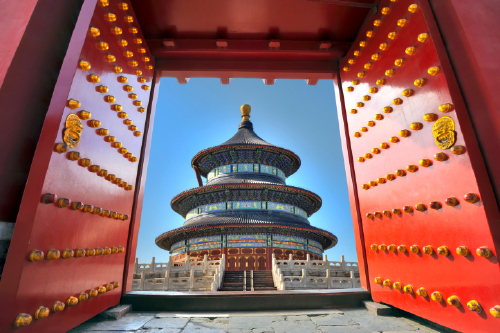 A complete masterpiece of Ancient Chinese culture, the Temple of Heaven, literally the Altar of heaven, is a magnificent and colourful complex of religious buildings, dating back to the Ming Dynasty in 1420 A.D. The temple was built as a sacred site to offer sacrifice to heaven, and no Chinese emperors at the time dared to build their own residence bigger than this dwelling for heaven.
A complete masterpiece of Ancient Chinese culture, the Temple of Heaven, literally the Altar of heaven, is a magnificent and colourful complex of religious buildings, dating back to the Ming Dynasty in 1420 A.D. The temple was built as a sacred site to offer sacrifice to heaven, and no Chinese emperors at the time dared to build their own residence bigger than this dwelling for heaven.
Set in beautiful gardens and surrounded by historic pinewoods, the cult buildings within the complex symbolise the relationship between heaven and earth; the northern part depicts heaven, and is designed to be semicircular and higher than the southern part, which is square-shaped and lower, symbolising earth. Located south of the Forbidden City – this UNESCO World Heritage site also has a 193-metre Echo Wall that utilises the theory of sound wave, in that people on both ends of the wall could whisper and still hear each other.
Halong Bay, Vietnam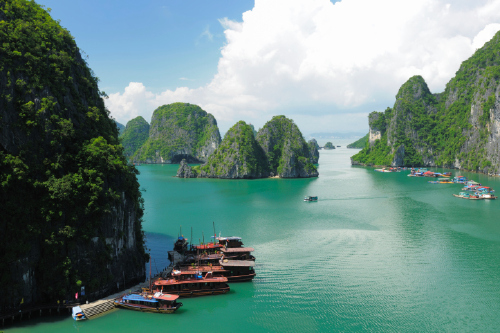 This is a landmark that is purely the handy work of nature itself. Halong Bay is a majestic natural wonder in the Gulf of Tonkin, dotted with thousands of islands floating in emerald green waters. Many of the beautiful limestone islands are hollow with enormous caves and amazing rock formations, sculpted by years of work, of the wind and water. Visitors are guaranteed an unforgettable time and are urged to rent a kayak or a junk boat to get up-close and explore their surroundings here. This is truly the most beautiful bay in all of Asia.
This is a landmark that is purely the handy work of nature itself. Halong Bay is a majestic natural wonder in the Gulf of Tonkin, dotted with thousands of islands floating in emerald green waters. Many of the beautiful limestone islands are hollow with enormous caves and amazing rock formations, sculpted by years of work, of the wind and water. Visitors are guaranteed an unforgettable time and are urged to rent a kayak or a junk boat to get up-close and explore their surroundings here. This is truly the most beautiful bay in all of Asia.
Petra, Jordan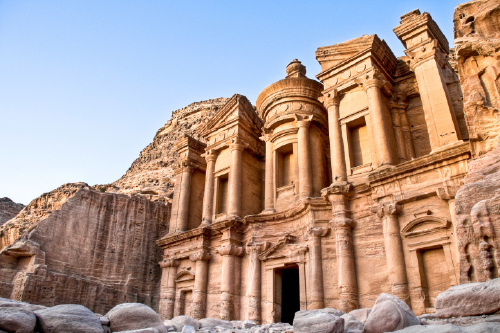 You will recognise this world wonder from the Indiana Jones films, among others, and Petra is a place nothing short of awe-inspiring. The Arabian historical and archaeological city is famous for being cut and carved into the face of sheer red rock by the Nabatean people who settled in the area more than 2000 years ago.
You will recognise this world wonder from the Indiana Jones films, among others, and Petra is a place nothing short of awe-inspiring. The Arabian historical and archaeological city is famous for being cut and carved into the face of sheer red rock by the Nabatean people who settled in the area more than 2000 years ago.
Petra is also famous for its water conduit system, and back when it was formed, the Nabataeans used it as a gateway for trade routes including silks and spices, linking China, India and southern Arabia with Egypt, Greece, Rome and Syria. As you enter Petra Valley, towering red rocks between which beautiful pathways have been paved, will greet you. The most famous structure in the city is the Treasury, though there is so much more to see. To this day, Petra is Jordan’s most treasured landmark and visitors should put aside 4-5 days to really explore the city.
Charyn Canyon, Kazakhstan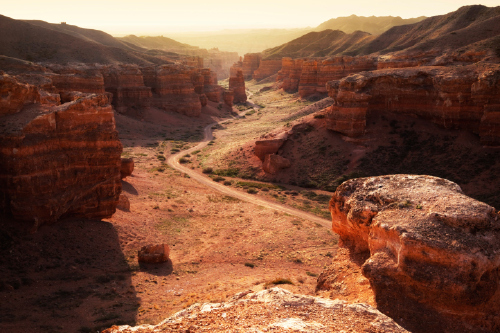 This is Asia’s answer to America’s Grand Canyon, though on a smaller scale. It is a 3-4 hour drive from the former capital city of Kazakhstan, Almaty, but definitely well worth it. The natural distinctive landscape the 200 kilometre canyon provides is simply stunning. Magnificent formations and colour, like the red clay walls of the canyon, are created through years of erosion and weathering.
This is Asia’s answer to America’s Grand Canyon, though on a smaller scale. It is a 3-4 hour drive from the former capital city of Kazakhstan, Almaty, but definitely well worth it. The natural distinctive landscape the 200 kilometre canyon provides is simply stunning. Magnificent formations and colour, like the red clay walls of the canyon, are created through years of erosion and weathering.
If you explore deep enough you will find that the “mini-Grand Canyon” is inhabited by strangely carved crevices and caves, and fantastic creatures. The Charyn Canyon is an exotic place that is largely deserted and less discovered by tourism, making for a more relaxing, peaceful and worthwhile visit.
The Batu Caves, Kuala Lumpur, Malaysia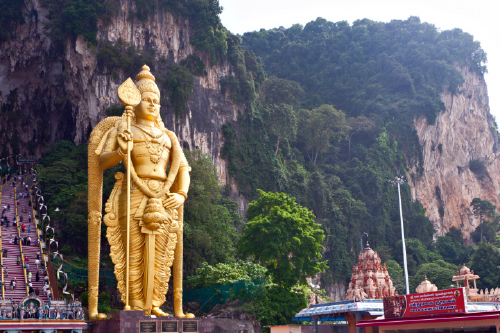 Probably the biggest blast of nature in K.L, The Batu Caves is a limestone hill housing a labyrinth of spooky caves. This exceptional geographical tourist trap can be appreciated by anyone willing to tackle the testing 272-step climb to marvel the splendid grottos. The caves take their name from the Sungai Batu or Batu River, which flows past the hill in which they are situated and the impressive area is also used for Hindu festivals and pilgrimages.
Probably the biggest blast of nature in K.L, The Batu Caves is a limestone hill housing a labyrinth of spooky caves. This exceptional geographical tourist trap can be appreciated by anyone willing to tackle the testing 272-step climb to marvel the splendid grottos. The caves take their name from the Sungai Batu or Batu River, which flows past the hill in which they are situated and the impressive area is also used for Hindu festivals and pilgrimages.
Kegon Falls, Japan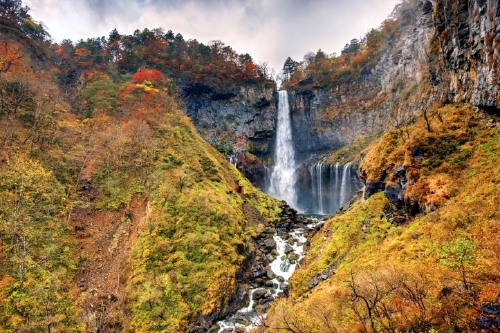 Serene and mesmerising, Kegon Falls is located at Lake Chūzenji in NikkŠNational Park. The almost 100m high falls make for a great day trip as beautiful scenery can be enjoyed on the drive up the mountain to the falls, which itself has a great observation deck from where you can really appreciate the beauty and charm of this natural wonder.
Serene and mesmerising, Kegon Falls is located at Lake Chūzenji in NikkŠNational Park. The almost 100m high falls make for a great day trip as beautiful scenery can be enjoyed on the drive up the mountain to the falls, which itself has a great observation deck from where you can really appreciate the beauty and charm of this natural wonder.
The falls were formed when the Daiya River was diverted by lava flows, and many say that autumn and winter are wonderful times to visit the falls due to colourful surroundings and to see the frozen icicles by the side of it splash down into the water. You can also pay a visit to the quaint village near the falls that has an outdoor food market on certain days, offering local produce.
Tell us what your favourite landmarks are in Asia. Comment below or tweet us @FemaleFirst_UK
FemaleFirst
Tagged in Travel AsiA Japan travel tips Travel Advice India Landmarks China

